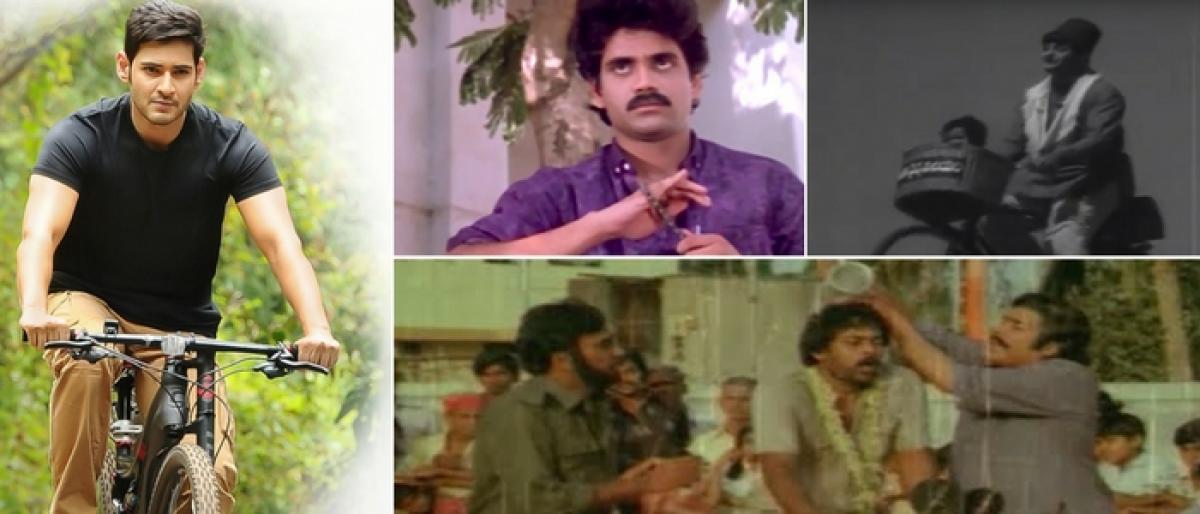Live
- Goa Aces clinch Indian Racing League title
- Study finds how hormone therapy can reshape the skeleton
- High-street fashion players looking at India for manufacturing: Report
- Shreyas Iyer to lead Mumbai as Prithvi Shaw returns for Syed Mushtaq Ali Trophy
- 'Failed to resolve crisis': NPP withdraws support from BJP govt in Manipur
- Chennai: Actress Kasturi Remanded in Custody Until 29th of This Month
- Aaqib Javed likely to become Pakistan's new white-ball head coach
- BJP panel to draft poll charge sheet against AAP govt in Delhi
- Allu Arjun Thanks Fans in Patna, Teases 'Pushpa 2' Release
- Japan to strengthen measures against illegal part-time jobs
Just In

JD and his gang of cronies are waiting to round up on Siva at cycle stand in the college. As Siva approaches the cycle stand, JD taunts and asks him if he was a hero; an angry Siva punches JD, breaks a cycle chain and beats the gang of cronies black and blue.
June 12 marked 200 years of first cycle ride in the world. In line with it, let us examine the roller-coaster ride of the cycle, which was extensively used in movies
JD and his gang of cronies are waiting to round up on Siva at cycle stand in the college. As Siva approaches the cycle stand, JD taunts and asks him if he was a hero; an angry Siva punches JD, breaks a cycle chain and beats the gang of cronies black and blue.
This iconic scene from Ram Gopal Varma’s ‘Siva’ (1989) created ripples across the State when it was released and is still one of the much talked about scenes. With the scene RGV, not only introduced new age protagonist to Telugu audience but also made cycle a weapon for violence.
Cycle until then in Telugu cinema was used as a tool to depict the economic status of the protagonists. In the movies of late 40s and 50s, the cycle was very much a symbol of upper middle-class. Rather than male leads, directors opted female leads to ride the cycle and often used the visuals to depict women empowerment in those times.
In ‘Kumkuma Rekha’ (1960), a song was canned on Balayya and Savitri, who ride a double cycle throughout the song, which goes like “Teerenu Korika Teeya Teeyaga...”. It was one of the very few songs of those times that were shot on lead pair, while they were riding a bicycle.
In the same year, Nageswara Rao starrer ‘Pelli Kanuka’ was released, which saw extensive shots of lead pair riding frequently on cycles. As the 60s progressed; cycle was frequently used in the films. The 1967 release ‘Pinni’ saw first teasing song shot while a pair were riding cycles. “Cyclepai Vannelaadi Potunnaadi...” penned by Kosaraju, superbly rendered by Pithapuram Nageswara Rao and shot on comedian Rajababu and actress Vijaya Nirmala, the song was a rage in those days.
In ‘Oke Kutumbam’ (1970), there is a song that mocks the disparities in the societies based on religion, caste and other divides. It was shot on NT Rama Rao, who rides a bicycle throughout the song. The movie has a distinction of being the only movie in which NTR played a role of Muslim.
With income increasing in the country, cycles were seen more on roads in the 70s as was the case in the movies. Back in those times in many towns and villages, there used to be competitions like riding cycles for days together without landing foot on the ground and it accompanied with a grand cash prize.
This competition was used to change the fortunes of the protagonist in Chiranjeevi starrer - ‘Maga Maharaju’ (1983). Director Vijaya Bapineedu’s use of inspirational song “Nee Daari Poola Daari...” composed by Chakravarty elevated the sequence.
After ‘Siva’, which also has a gripping and hair rising chase sequence on cycle, the use of cycle in key scenes in movies increased manifold, throughout the 90s. In the 2000s the stature of the cycle as youth vehicle took a side step, and motorcycles become a rage.
The stature of cycle has been reduced to that of lower middle- class vehicle It was SS Rajamouli in 2010, who immortalised cycle, as he made it a character in action-comedy ‘Marayada Ramanna’. Voiced by Ravi Teja, Rajamouli made sure that hilarious lines were written for the character.
Director Koratala Siva in ‘Srimanthudu’ (2015) not only restored the legacy of the cycle in cinemas as a youth vehicle but also used Mahesh Babu riding a cycle as a symbol of denouncing wealth. The song “Po Ra Srimanthuda...” with inspirational lyrics by Ramajogayya Sastry and soulful rendition by MLR Karthikeyan reinstated the cycle’s image.
He followed the suit with the song “Jaago...” in the same film and repeated the feat in his next and NTR - starrer ‘Janata Garage’, wherein he shot a few sequences of the song “Rock On Bro...” on the protagonist and his friends riding cycles.
The cycle is an important mode of transport. Its status might change in the films but it will never be out of vogue.

© 2024 Hyderabad Media House Limited/The Hans India. All rights reserved. Powered by hocalwire.com







